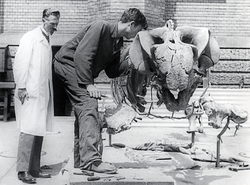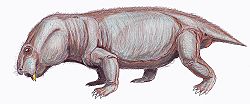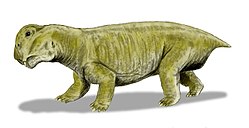| Stahleckeria Temporal range: Mid Triassic ~ | |
|---|---|
 | |
| Stahleckeria potens | |
| Scientific classification | |
| Domain: | Eukaryota |
| Kingdom: | Animalia |
| Phylum: | Chordata |
| Clade: | Synapsida |
| Clade: | Therapsida |
| Suborder: | † Anomodontia |
| Clade: | † Dicynodontia |
| Family: | † Stahleckeriidae |
| Subfamily: | † Stahleckeriinae |
| Genus: | † Stahleckeria von Huene, 1935 |
| Species: | †S. potens |
| Binomial name | |
| †Stahleckeria potens von Huene, 1935 | |
Stahleckeria is an extinct genus of Middle Triassic (Ladinian) dicynodonts. [1] It lived about 240 million years ago in what is now Brazil and Namibia. As a member of the group Kannemeyeriiformes, it was similar to the genus Kannemeyeria . The genus is known from the type species Stahleckeria potens, which was first collected from the Ladinian-age Santa Maria Formation in the Paleorrota fossil site of Brazil. Stahleckeria was named in honor of Rudolf Stahlecker, who discovered the first specimens during a 1935 expedition led by paleontologist Friedrich von Huene to the Chiniquá fossil site.








